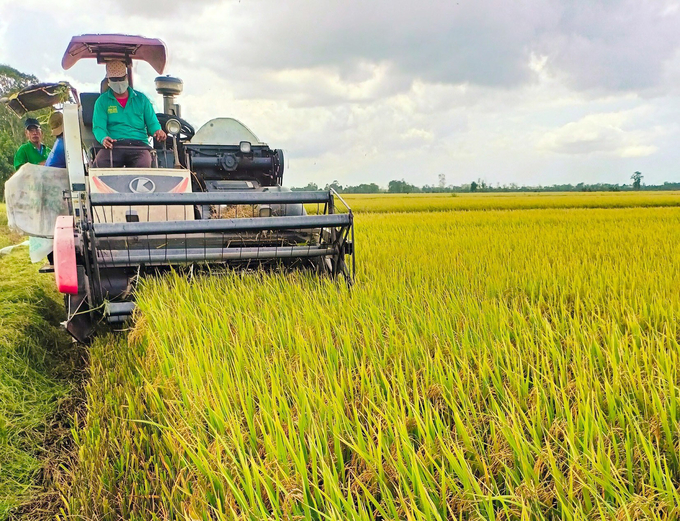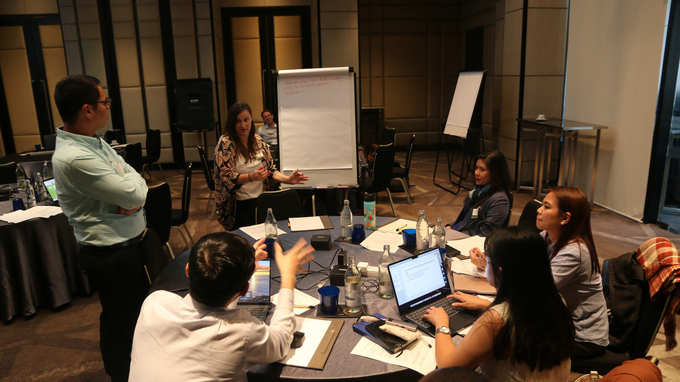May 29, 2025 | 08:54 GMT +7
May 29, 2025 | 08:54 GMT +7
Hotline: 0913.378.918
May 29, 2025 | 08:54 GMT +7
Hotline: 0913.378.918

Dr. Alisher Mirzabaev is an IRRI scientist specializing in economics and climate change. Photo: Quynh Chi.
Some working on developing a carbon market for rice find it difficult to understand the numerous legal and technical terms, particularly those related to the Paris Agreement's Article 6, voluntary and compulsory carbon market standards. This jargon often alienates the broader public, including farmers, who are crucial stakeholders in carbon reduction efforts.
For Dr. Alisher Mirzabaev, an IRRI scientist specializing in economics and climate change, the primary concern is how the carbon market can tangibly benefit farmers. Farmers prioritize making a sustainable living, which includes ensuring their families' well-being and securing educational opportunities for their children. For farmers to commit to reducing greenhouse gas emissions, there must be clear, profitable incentives for them.
Vietnam Agriculture News spoke with Dr. Mirzabaev to explore areas in which farmers can benefit from carbon farming by adopting technologies that reduce methane emissions.

Carbon farming requires investment in digital and technological transformation. Photo: Thanh Son.
First of all, thank you so much for doing this and helping us conceptualize things in simple terms. From the perspective of a researcher in economic and policy, how do you assess the potential of the carbon market right now?
Dr. Mirzabaev: There’s a general effort to make these terminologies and their meanings accessible. It is crucial for policymakers and scientists that farmers are involved in this transformative process.
From the farmers' perspective, their priority is making a living. They must take care of their families and ensure they have enough profit to send their children to school. How does this carbon market help with that? How will methane reductions help them? Farmers are not committed to reducing greenhouse gas emissions unless it’s profitable for them. So, how can they benefit from this?
One way is through technologies that reduce methane emissions, such as water management, alternate wetting and drying, and direct seeding of rice. Another is through site-specific nutrient management to reduce nitrous oxide emissions.
For example, methane (CH4) emissions occur when rice fields are flooded, and soil bacteria digest organic material, releasing methane. Fertilizer use leads to nitrous oxide (NO2) emissions. In our project, we focus more on methane reduction.
Farmers can achieve methane reductions equivalent to three tons of carbon per hectare by applying these technologies. If one ton is sold for 10 USD, that means 30 USD per hectare. However, this doesn’t account for the farmers' costs, and 30 USD might not be enough to motivate them to change their practices.
The low price is due to buyers' doubts about the quality of this carbon. Buyers can be companies or foreign entities, such as energy companies needing to offset their emissions.
I would like to shift from carbon financing to how farmers can participate in these projects. If the benefit does not lie in money, what are the benefits?
Dr. Mirzabaev: I think benefits should lie in the money because everyone responds to incentives, especially farmers. During a webinar, farmers asked about the profit they could make from these technologies. If 10 USD per ton of carbon is not enough, we must improve the system to offer more. Just like rice quality affects its price – ranging from one dollar to three dollars per kilogram – carbon quality should affect its price.
High-quality carbon ensures no leakage (i.e., reducing emissions in one area without increasing them elsewhere) and maintains environmental sustainability. Creating a system guaranteeing high-quality, credible carbon can lead to higher prices than 10 USD per ton.

For farmers, the benefits of carbon farming should lie in money.
Another advantage is about thirty percent water savings, which is especially useful during frequent droughts. However, carbon markets will not account for water savings if they happen naturally, such as during low rainfall or droughts. Farmers benefit by improving their resilience to climate change through better water management.
Water services are priced in some countries, and water costs can be high. For example, in Bangladesh, the cost includes delivery services, sometimes requiring underground pumping. In Vietnam, water pricing is not volumetric; farmers pay a flat rate regardless of usage. However, in Bangladesh, charging per cubic meter encourages the adoption of Alternate Wetting and Drying (AWD) technology.
Thus, policy design significantly impacts project implementation in different countries.
Can you share about your experience working and surveying the farmers in Vietnam?
Dr. Mirzabaev: We are just starting the surveys in this USAID-funded project on Methane Accelerator in Southeast Asia (MASEA), but I’ve seen that farmers’ situations are very diverse. There are big differences in practices and crop rotations among locations. We aim to consider these differences and inform many processes currently underway by developing investment roadmaps at the national level in Vietnam.
Most of our work focuses on the Mekong Delta, but our survey also includes the Red River Delta and central parts of Vietnam. This will provide a more comprehensive understanding of these regions, not just the Mekong Delta but also the significant contributions of the Red River Delta and others.

Workshop within the framework of the USAID-funded project on Methane Accelerator in Southeast Asia (MASEA). Photo: IRRI.
We plan to focus on irrigated areas and dry-season farming. Various farming systems, such as rice monocropping, rice-fish, and shrimp-rice rotations, must be considered for a thorough investment analysis. This analysis will help identify where carbon market investments are most profitable.
We will also use scenario planning. For example, we’ll analyze the feasibility of $10 per ton of carbon. We'll conduct choice modeling experiments with farmers to understand their behavior and preferences. If $10 per ton is not sufficient, we will explore what happens at $20 or $50 per ton. For instance, at $50 per ton, farmers could earn $150 per hectare. This will help us determine the necessary carbon price for viability.
Additionally, we will explore other mechanisms, such as water savings and how they motivate the adoption of technologies that reduce methane emissions. Currently, irrigation water costs do not significantly affect farmers’ production costs in Vietnam, so they might not consider water saving as important. Administrative mechanisms could help encourage water savings, but market-based incentives are likely more effective.
What are the immediate next steps?
Dr. Mirzabaev: The next steps will involve conducting farmer surveys. We will ask farmers about their current practices and explain technologies like AWD that help reduce methane emissions. We will try to find out what would be the extent of additional profits that will allow them to adopt these technologies such as AWD.
We will also ask farmers how they prefer to organize to participate in carbon markets. In Vietnam, for example, cooperative form of organization can play an important role, which is a strength because AWD adoption can’'t happen at the individual farm level. Buyers also prefer working with aggregated groups of farmers rather than individual ones. We will explore different business models and institutional arrangements, such as contract farming, and see which farmers prefer.

To price carbon credits high, Vietnamese farmers need to standardize monitoring, reporting and verification (MRV) processes related to the environment and sustainability indicators.
What about payment preferences?
Dr. Mirzabaev: We will ask if farmers prefer to be paid at the beginning of the year or if the price should change according to the market. Through these surveys, we aim to identify the supply curve. We might use choice modeling to see how farmers react to different payment scenarios.
For example, if rice prices go up, farmers will want to sell more rice because they can earn more money. Similarly, if the price of carbon increases, we need to see if more farmers will be willing to participate. We will examine how carbon price increases from $10 to $50 per ton impact the number of hectares under sustainable rice production. As the carbon price increases, we might see an expansion in low-emission, sustainable rice production.
What are your contributions from the economics side?
Dr. Mirzabaev: Our contributions would be twofold. First, we would provide options for investment roadmap for public and private stakeholders. This roadmap will help determine where investing in low-emission rice makes the most sense. It will outline how much investment is needed, the per-hectare cost, and the potential profit for farmers. This guide will also help prioritize investments, starting with the most profitable areas.
Second, we will explore viable institutional mechanisms and business models, such as cooperatives, to help farmers participate in carbon markets. We will examine the scientific evidence to determine why one model might be better.
In Vietnam, a middleman collects rice from the field and transfers it to the factories. How do you take this middleman into account?
Dr. Mirzabaev: Yes, there are two key considerations. First, farmers should be paid to reduce methane emissions regardless of the fluctuations in rice prices. They would be compensated by carbon markets for their results in reducing methane emissions, irrespective of rice price changes in the market.

Farmers should be compensated by carbon markets for their results in reducing methane emissions, irrespective of rice price changes in the market.
Payments can be made based on activities or outcomes. Activity-based payments mean farmers follow specific practices, like the number of draining and flooding events, regardless of the actual methane reduction. Outcome-based payments are made after measuring the actual reduction in methane emissions. Scientific evidence overwhelmingly supports outcome-based payments as being more effective in achieving emission reductions.
Generally, addressing the rice value chains is crucial. Farmers should be paid directly for their management practices that reduce emissions. Understanding and integrating the entire rice value chains will help create a more effective and equitable system for all stakeholders.
Translated by Quynh Chi
/2025/05/25/4127-3-073637_820.jpg)
(VAN) Thanks to the promotion from an FAO-implemented project, vegetable production in greenhouses in Moc Chau has seen strong development, from 1.5 hectares in 2021 to nearly 50 hectares in 2024.

(VAN) FAO has recently supported USD 140,000 to implement the project 'Risk mitigation human-animal interface risks through disease control initiatives in pig farming.'

(VAN) The People's Committee of Tra Vinh province has approved an adjustment to the investment policy for the Green Hydrogen Plant project, increasing its area to approximately 52.76 hectares.
![Reducing emissions from rice fields: [2] Farmers’ commitment to the soil](https://t.ex-cdn.com/nongnghiepmoitruong.vn/608w/files/news/2025/05/05/dsc08881jpg-nongnghiep-140632.jpg)
(VAN) Clean rice cultivation model in Thuong Tan commune, Bac Tan Uyen district, is assisting local residents in achieving sustainable agriculture by substantially reducing costs, increasing productivity, and protecting the environment.

(VAN) At the conference to disseminate Resolution No. 68, AgriS introduced its digital agricultural ecosystem and reaffirmed its commitment to accompanying the Government in promoting private sector development and sustainable agriculture.

(VAN) 'Blue Ocean - Blue Foods' initiative is designed to restore marine ecosystems and establish sustainable livelihoods for local communities by cultivating a minimum of 1,000 hectares of cottonii seaweed in the first three years.
/2025/05/21/4642-3-112707_603.jpg)
(VAN) The V-SCOPE project has made direct contributions to three out of six pillars of the Comprehensive Strategic Partnership between Vietnam and Australia.